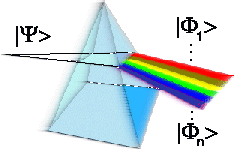Mirosław Brewczyk, Peter Borowski, Mariusz Gajda and Kazimierz Rzążewski
A classical field approximation to the finite temperature microcanonical thermodynamics of weakly interacting Bose gases is applied to the idealized case of atoms confined in a box with periodic boundary conditions. The whole isolated system is described by a set of classical amplitudes. We show that if the system is in equilibrium the classical amplitudes follow the equipartition theorem which allows us to assign a unique temperature to each given energy state. We also analyse the spectral properties of classical amplitudes and obtain nonperturbative results for the chemical potential as well as temperature-dependent Bogoliubov frequencies and their damping rates. Where available, we make comparison with the analytical estimates of these quantities.
J. Phys. B: At. Mol. Opt. Phys. 37 2725-2738
May 17, 2004
May 7, 2004
Dynamics of Argon Clusters in an Intense Laser Pulse: Bloch-Like Hydrodynamic Model
M. Rusek and A. Orłowski
The dynamics of small (≤55 atoms) argon clusters ionized by an intense, infrared, femtosecond laser pulse is studied using a Bloch-like hydrodynamic model. Evolution of both free electrons and ions formed in the cluster explosion process is examined. Oscillations of the electron cloud in a rare-gas atomic cluster are described as a motion of a fluid obeying Bloch-like hydrodynamic equations. Our theoretical approach includes all possible ionization mechanisms: tunnel (or field) ionization both by an external laser field, and by an internal field due to the space-charge distribution inside the cluster, as well as electron-impact (or collisional) ionization. The results of our simulations are compared both with experimental findings and with predictions of other theoretical models.
Acta Phys. Polonica A, Vol. 106 No 1
The dynamics of small (≤55 atoms) argon clusters ionized by an intense, infrared, femtosecond laser pulse is studied using a Bloch-like hydrodynamic model. Evolution of both free electrons and ions formed in the cluster explosion process is examined. Oscillations of the electron cloud in a rare-gas atomic cluster are described as a motion of a fluid obeying Bloch-like hydrodynamic equations. Our theoretical approach includes all possible ionization mechanisms: tunnel (or field) ionization both by an external laser field, and by an internal field due to the space-charge distribution inside the cluster, as well as electron-impact (or collisional) ionization. The results of our simulations are compared both with experimental findings and with predictions of other theoretical models.
Acta Phys. Polonica A, Vol. 106 No 1
Subscribe to:
Comments (Atom)
